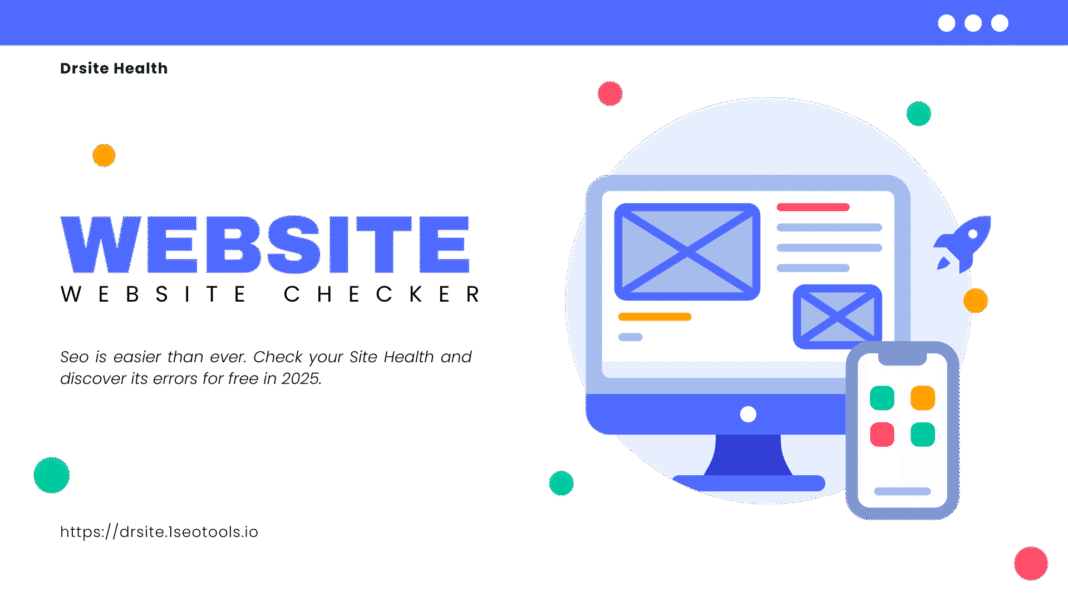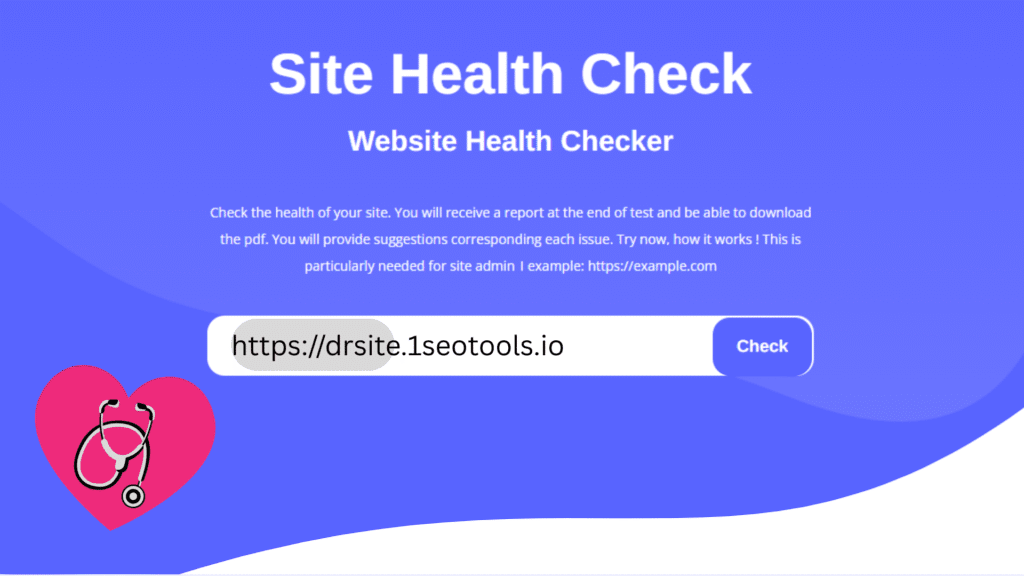
Run a free 2025 website health check: audit presentation, SEO, security, speed, backlinks & reports. Optimize your site, boost ranking & performance now!

Why Check Your Website Health?
Importance of Regular Website Analysis
Keeping a finger on the pulse of your site isn’t a “nice to have”—it’s critical. Regular audits help you:
- Catch technical errors (404s, broken links, crawl issues) before they tank your rankings.
- Uncover content gaps and thin pages that dilute keyword relevance.
- Ensure mobile‑friendliness (Google’s mobile‑first index rewards responsive design).
- Monitor Core Web Vitals (Largest Contentful Paint, First Input Delay, Cumulative Layout Shift) to satisfy page‑experience signals.
On‑Page Tip: Use an HTML sitemap and clear breadcrumb markup so both users and crawlers navigate easily.
Business Benefits: From Traffic to Trust
A healthy site translates directly into:
- More Organic Traffic—search engines favor error‑free, fast, secure sites.
- Lower Bounce Rates—users stay when pages load instantly and content matches intent.
- Higher Conversion Rates—trust signals (SSL lock, clean UX) boost form submissions and sales.
- Brand Authority—consistent audits demonstrate to Google you’re invested in quality.
On‑Page Tip: Sprinkle LSI keywords (related terms) naturally in your copy to capture long‑tail queries.
Why Choose Dr. Website Checker (RankWatch)?
Dr. Website Checker is built for both beginners and SEO pros:
- Free, No‑Credit‑Card Audit: Instant, comprehensive report in under 60 seconds.
- White‑Label & Custom Reports: Perfect for agencies delivering branded insights.
- Automated Alerts: Schedule weekly or monthly scans so you never miss an issue.
On‑Page Tip: Create an internal link from your blog to your tool’s landing page using keyword‑rich anchor text (e.g. “free website health checker”).
How “Check Website Health” Works
What Is Dr. Website Checker?
A cloud‑based crawler that simulates Googlebot, Dr. Website Checker scans every URL on your domain to surface technical, on‑page, and off‑page issues—all in one dashboard.
Image Prompt: “Sleek dashboard showing website health overview with charts for SEO, speed, security, and backlinks.”

What the Tool Tests
- Technical SEO: Crawlability, indexation, XML sitemap, robots.txt
- On‑Page SEO: Title tags, meta descriptions, heading hierarchy, keyword density
- Performance: Page load times, image optimization, caching status
- Security: SSL configuration, mixed content, HTTP headers (HSTS, CSP)
- Backlinks: Quantity, quality, anchor‑text distribution
- Competitor Analysis: Side‑by‑side metrics on traffic and keywords
On‑Page Tip: For every issue flagged, link to a help article—this builds internal authority and keeps users engaged.
H3. Behind the Scenes: How the Tool Operates
- Crawl Phase: Starts at your homepage, follows internal links, and builds a URL map.
- Audit Phase: Each URL is tested against 100+ SEO and performance rules.
- Analysis Phase: Results are scored, prioritized, and displayed with actionable recommendations.
On‑Page Tip: Implement structured data (Schema.org) for FAQs, breadcrumbs, and organization info to enhance SERP appearance.
On‑Page Tip: Create a comparison table with HTML <table> markup so search engines can feature it as a rich snippet.
Core Aspects Reviewed by “Check Website Health”
Website Presentation
Be Present Online
- Domain Authority & Indexation: Are all key pages in Google’s index?
- URL Structure: Short, keyword‑rich, hyphenated URLs outrank messy parameters.
- Sitemaps & Robots.txt: Ensure your sitemap.xml is up‑to‑date and robots.txt isn’t blocking vital sections.
Image Prompt: “Illustration of a site map tree with green checkmarks on indexed URLs.”
Search Engine Visibility
Get Found
- Title Tags & Meta Descriptions: Unique, compelling, 50–60 chars (title) and 120–155 chars (meta).
- Heading Hierarchy (H1–H6): One H1 per page, then H2s and H3s to structure content logically.
- Schema Markup: FAQ, Article, Product schemas increase click‑through rates.
- Internal Linking: Use descriptive anchor text to distribute link equity.
On‑Page Tip: Compress images and add loading=”lazy” to speed up page rendering and satisfy Core Web Vitals.
Security Checks
Be Secure
- SSL/TLS Configuration: All pages must load via HTTPS; redirect HTTP to HTTPS.
- Mixed Content Audit: No insecure scripts or images on secure pages.
- Security Headers: Implement HSTS, X‑Frame‑Options, Content Security Policy.
On‑Page Tip: Add a security badge or “HTTPS” icon near your contact form to boost user trust and conversions.
Speed & Performance
Be Fast
- Core Web Vitals: LCP <2.5 s, FID <100 ms, CLS <0.1.
- Asset Optimization: Minify CSS/JS, use GZIP/Brotli compression.
- CDN Usage: Offload static assets to a Content Delivery Network.
- Image Formats: Serve WebP or AVIF where supported.
Image Prompt: “Bar chart of Core Web Vitals scores for desktop vs. mobile.”
Backlink Profile
- Link Quality Over Quantity: Disavow toxic or irrelevant domains.
- Anchor‑Text Diversity: Natural mix of branded, exact‑match, and long‑tail anchors.
- New vs. Lost Links: Track gain/loss trends to guide outreach strategy.
On‑Page Tip: Link out to one authoritative external source per 300–500 words to enhance topical relevance.
Competitor Strategy Analysis
- Keyword Gap Analysis: Identify keywords your competitors rank for but you don’t.
- Backlink Overlap: Find shared high‑authority links and pursue the same.
- Content Benchmarking: Compare word count, readability, and media usage against top‑ranking pages.
On‑Page Tip: Publish “skyscraper” content—longer, more in‑depth posts than your competitors—to dominate SERPs.
Top On‑Page SEO Techniques Recap:
- Optimize Titles & Metas with primary and LSI keywords.
- Structured Headings (H1→H2→H3) for clear content hierarchy.
- Schema Markup for rich snippets.
- Internal & External Linking for authority flow.
- Image Optimization: descriptive filenames, alt‑text, modern formats, lazy loading.
- Mobile‑First Design & Core Web Vitals compliance.
- Content Depth: 1,500+ words where appropriate, covering subtopics comprehensively.
- Page Speed: minification, compression, CDN.
- Security Best Practices: HTTPS everywhere, security headers.
- Regular Audits using “Check Website Health” to stay ahead of issues.
How “Check Website Health” Works
What Is Dr. Website Checker?
A cloud‑based crawler that simulates Googlebot, Dr. Website Checker scans every URL on your domain to surface technical, on‑page, and off‑page issues—all in one dashboard.
Image Prompt: “Sleek dashboard showing website health overview with charts for SEO, speed, security, and backlinks.”
What the Tool Tests
- Technical SEO: Crawlability, indexation, XML sitemap, robots.txt
- On‑Page SEO: Title tags, meta descriptions, heading hierarchy, keyword density
- Performance: Page load times, image optimization, caching status
- Security: SSL configuration, mixed content, HTTP headers (HSTS, CSP)
- Backlinks: Quantity, quality, anchor‑text distribution
- Competitor Analysis: Side‑by‑side metrics on traffic and keywords
On‑Page Tip: For every issue flagged, link to a help article—this builds internal authority and keeps users engaged.
Behind the Scenes: How the Tool Operates
- Crawl Phase: Starts at your homepage, follows internal links, and builds a URL map.
- Audit Phase: Each URL is tested against 100+ SEO and performance rules.
- Analysis Phase: Results are scored, prioritized, and displayed with actionable recommendations.
On‑Page Tip: Implement structured data (Schema.org) for FAQs, breadcrumbs, and organization info to enhance SERP appearance.
Free vs. Premium Features
| Feature | Free Plan | Premium Plan |
| Weekly Automated Scans | ✓ | ✓ |
| White‑Label Reporting | ✓ | |
| API Access | ✓ | |
| Historical Data & Trends | 30 days | Unlimited |
| Competitor Benchmarking | 1 competitor | Up to 10 |
On‑Page Tip: Create a comparison table with HTML <table> markup so search engines can feature it as a rich snippet.
Core Aspects Reviewed by “Check Website Health”
Website Presentation
Be Present Online
- Domain Authority & Indexation: Are all key pages in Google’s index?
- URL Structure: Short, keyword‑rich, hyphenated URLs outrank messy parameters.
- Sitemaps & Robots.txt: Ensure your sitemap.xml is up‑to‑date and robots.txt isn’t blocking vital sections.
Image Prompt: “Illustration of a site map tree with green checkmarks on indexed URLs.”
Search Engine Visibility
Get Found
- Title Tags & Meta Descriptions: Unique, compelling, 50–60 chars (title) and 120–155 chars (meta).
- Heading Hierarchy (H1–H6): One H1 per page, then H2s and H3s to structure content logically.
- Schema Markup: FAQ, Article, Product schemas increase click‑through rates.
- Internal Linking: Use descriptive anchor text to distribute link equity.
On‑Page Tip: Compress images and add loading=”lazy” to speed up page rendering and satisfy Core Web Vitals.
H3. Security Checks
H4. Be Secure
- SSL/TLS Configuration: All pages must load via HTTPS; redirect HTTP to HTTPS.
- Mixed Content Audit: No insecure scripts or images on secure pages.
- Security Headers: Implement HSTS, X‑Frame‑Options, Content Security Policy.
On‑Page Tip: Add a security badge or “HTTPS” icon near your contact form to boost user trust and conversions.
Speed & Performance
Be Fast
- Core Web Vitals: LCP <2.5 s, FID <100 ms, CLS <0.1.
- Asset Optimization: Minify CSS/JS, use GZIP/Brotli compression.
- CDN Usage: Offload static assets to a Content Delivery Network.
- Image Formats: Serve WebP or AVIF where supported.
Image Prompt: “Bar chart of Core Web Vitals scores for desktop vs. mobile.”
Backlink Profile
- Link Quality Over Quantity: Disavow toxic or irrelevant domains.
- Anchor‑Text Diversity: Natural mix of branded, exact‑match, and long‑tail anchors.
- New vs. Lost Links: Track gain/loss trends to guide outreach strategy.
On‑Page Tip: Link out to one authoritative external source per 300–500 words to enhance topical relevance.
Competitor Strategy Analysis
- Keyword Gap Analysis: Identify keywords your competitors rank for but you don’t.
- Backlink Overlap: Find shared high‑authority links and pursue the same.
- Content Benchmarking: Compare word count, readability, and media usage against top‑ranking pages.
On‑Page Tip: Publish “skyscraper” content—longer, more in‑depth posts than your competitors—to dominate SERPs.
Discover more free SEO tools by visiting our website: Click here
Top On‑Page SEO Techniques Recap:
- Optimize Titles & Metas with primary and LSI keywords.
- Structured Headings (H1→H2→H3) for clear content hierarchy.
- Schema Markup for rich snippets.
- Internal & External Linking for authority flow.
- Image Optimization: descriptive filenames, alt‑text, modern formats, lazy loading.
- Mobile‑First Design & Core Web Vitals compliance.
- Content Depth: 1,500+ words where appropriate, covering subtopics comprehensively.
- Page Speed: minification, compression, CDN.
- Security Best Practices: HTTPS everywhere, security headers.
- Regular Audits using “Check Website Health” to stay ahead of issues.




















![SumoSEOTools PDF Addon Package Review [2025] Is it worth evaluating? SumoWebTools-Addon-Package](https://1seotools.io/wp-content/uploads/2025/03/SumoWebTools-Addon-Package-PDF-218x150.png)
![Always the Best SiteSpy : Visitor Tracking Analytics & SEO Review [2025] SiteSpy Visitor Tracking Analytics](https://1seotools.io/wp-content/uploads/2025/03/Visitors-analytics-2-218x150.png)
![Elevate Your SEO Strategy with Seo Tools Studio : Review [2025] Seo Studio Review 2025 | Professional Free SEO Tools](https://1seotools.io/wp-content/uploads/2025/03/studio-seo-tools-script-1-218x150.jpg)
![Review WP AMP — Accelerated Mobile Pages for WordPress & WooCommerce [2025] WP AMP — Accelerated Mobile Pages for WordPress & WooCommerce](https://1seotools.io/wp-content/uploads/2025/03/WP-AMP-for-WordPress-WooCommerce-218x150.png)
![Review of Prestashop SEO Optimizer Module-Advance SEO Expert Module [2025] Prestashop SEO Optimizer Module](https://1seotools.io/wp-content/uploads/2025/03/6-AdvanceSEOOptimizerRobot.txt-218x150.png)

